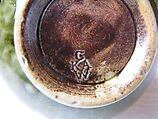Vase
Manufacturer Chelsea Keramic Art Works American
Designer Hugh C. Robertson
Steeped in ceramics from birth, Hugh C. Robertson pursued his craft with fierce devotion and a passion for experimentation. From a family of trained English ceramists, he honed his skills in New Jersey before settling in Massachusetts as one of the founders of Chelsea Keramic Art Works and later, Dedham Pottery. Robertson’s lifelong explorations in glazes, particularly their color and texture, make him one of the key figures of American art pottery at the turn of the twentieth century.
Glazes, an important aspect of the ceramist’s profession, gradually assumed a dominant role in Hugh Robertson’s career and even more so in a series of long-neck vases in the Ellison Collection. He often relied on transparent glazes in a limited range of colors — tertiary olive greens, blue greens, and blues — in a palette popular among Aesthetic and Arts and Crafts movement artists such as James McNeill Whistler and Arthur Wesley Dow. Robertson’s orchestration of hues and his concern with color for color’s sake were quite Whistlerian; indeed, a matte yellow vase in this series that was prized by the Robertsons was affectionately known as the "Whistler Vase." His elegant, Asian-inspired bottle shapes and his new colors date from at least 1877; Robertson’s gifts of his own work to the Museum of Fine Arts, Boston, from 1877 through 1882 help confirm when Robertson introduced the glazes. Vases described as having "gray blue" and "olive green" glazes were part of the 1877 gift. The 1878 gift record mentioned a vase with a "strong glaze" in "deep ultramarine blue," and the 1882 gift described another glaze as "dark blue green." The only dated bottle-shaped vase in the Ellison Collection, with a soft mustard-colored matte glaze, bears the incised inscription "Sep. 82."
This vase, and others like it, signaled Robertson’s growing infatuation with Asian ceramics. Many adherents of the Aesthetic movement were drawn to the Far East, Bostonians in particular. The area was home to three major collections of Asian art — those of William Sturgis Bigelow, Edward Sylvester Morse, and Ernest Fenellosa — but they consisted primarily of Japanese works. Robertson appears to have been especially inspired by the Chinese pottery and porcelain in George Washington Wales’s collection, seventy-two examples of which were lent to the Museum of Fine Arts as early as 1881. In fact, these Chinese vases were displayed in the same gallery as Robertson’s own work, suggesting the potter’s deep familiarity with the material. Certainly, the museum recognized the affinity between the two groups of ceramics. In his proclivity toward mustard yellow, pale blue, and blue gray, as well as varying shades of green, Robertson demonstrated his knowledge of eighteenth-century Chinese monochrome glazes.
This vase is from the Robert A. Ellison Jr. Collection of American art pottery donated to the Metropolitan Museum in 2017 and 2018. The works in the collection date from the mid-1870s through the 1950s. Together they comprise one of the most comprehensive and important assemblages of this material known.
This image cannot be enlarged, viewed at full screen, or downloaded.


